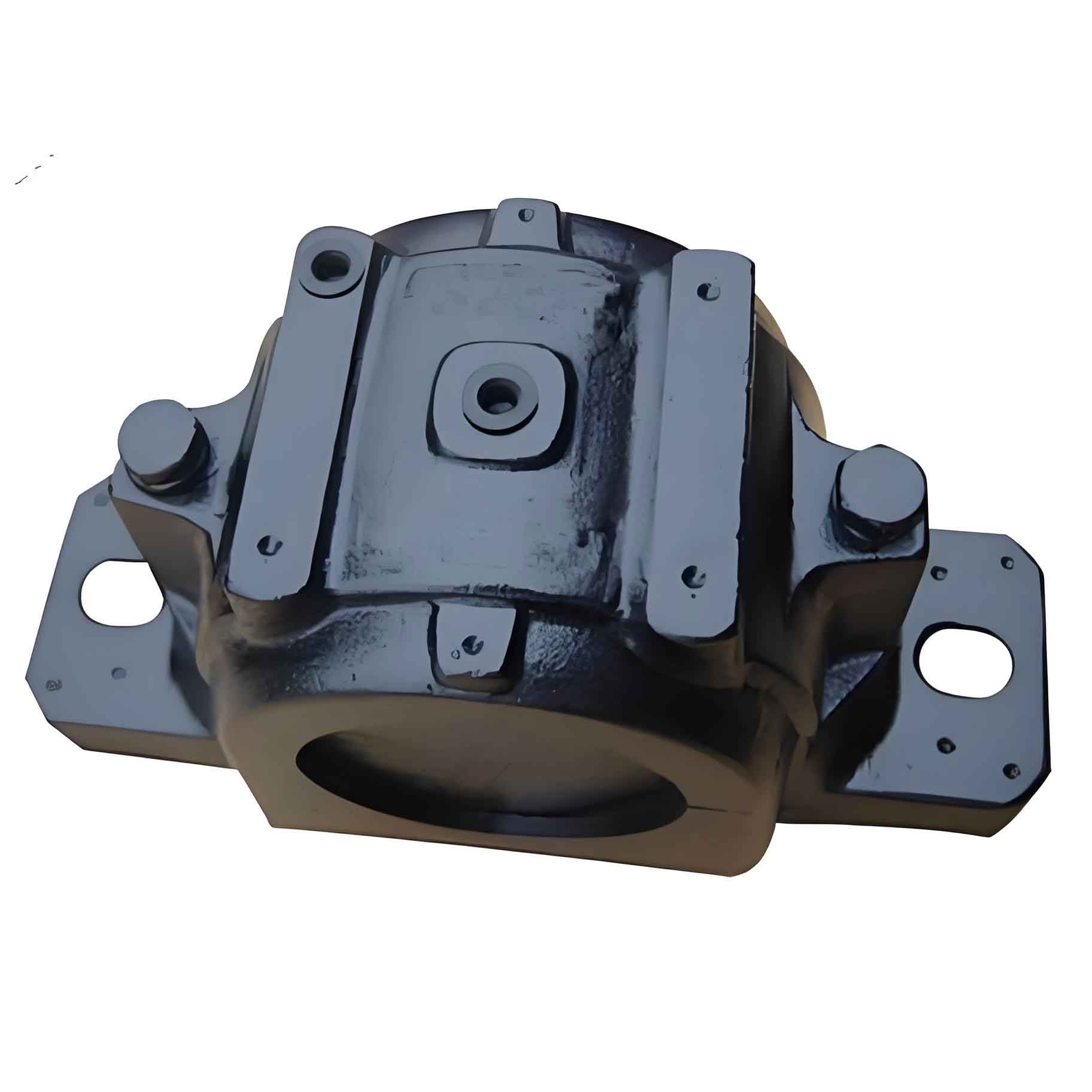This study examines how different mold parting strategies affect the quality and production efficiency of tractor transmission housings using rapid casting technologies. The research compares conventional segmented core approaches with an innovative integral core methodology, demonstrating significant improvements in dimensional accuracy, surface quality, and production cycle time for critical tractor casting components.

The transmission housing, manufactured in QT500-7 ductile iron with a weight of 458 kg and maximum dimension of 949 mm, serves as both a functional component and structural element in crawler tractors. Its performance requirements include minimum tensile strength of 500 MPa, yield strength of 320 MPa, and elongation of 7%, making casting integrity essential for this tractor casting application.
Conventional Segmented Core Process Limitations
Initial production employed a segmented core strategy dividing the mold into three sections due to complex internal geometries exceeding tool accessibility limits (maximum tool length = 100 mm vs feature depth = 114 mm). The casting system used a gating ratio of:
$$ \frac{F_{sprue}}{F_{runner}}{F_{ingate}} = 1.63:1.5:1 $$
with three feeder risers placed at thermal hotspots identified through CAE simulation. Production utilized multiple rapid manufacturing technologies:
| Process | Equipment | Application |
|---|---|---|
| Subtractive | 5-axis CNC milling | Core segments |
| Subtractive | 3-axis CNC milling | Drag/cope molds |
| Additive | Laser sintering | Complex inserts |
This approach introduced critical limitations for tractor casting production:
- Assembly dimensional stack-up error: 2.0 mm
- Surface porosity concentration at upper regions
- Extended machining time: 23 hours/core set
- Manual intervention requiring core segment joining
Integrated Core Process Optimization
The redesigned integral core strategy eliminated segmentation through strategic process modifications:
$$ \epsilon_{assembly} = \sum_{i=1}^{n} \delta_i = \delta_{\text{core}} + \delta_{\text{insert}} + \delta_{\text{assembly}} $$
where reducing core segments from n=3 to n=1 minimized cumulative tolerance:
| Error Source | Segmented Core (mm) | Integral Core (mm) |
|---|---|---|
| Machining tolerance | ±1.50 | ±0.15 |
| Insert bonding | ±0.50 | ±0.10 |
| Cumulative error | 2.00 | 0.25 |
Key technical improvements included:
- Unified core machining using 5-axis simultaneous processing with specialized toolpaths
- Strategic insert design for inaccessible regions manufactured via laser sintering
- Enhanced venting with three 80×20×300 mm vents (5° taper) added at critical locations:
$$ Q_{vent} = k \cdot A \sqrt{\frac{2 \Delta P}{\rho}} $$
where gas permeability (k) and vent area (A) prevent gas entrapment.

Production Efficiency Analysis
The integral core approach transformed equipment utilization patterns for tractor casting manufacturing:
| Resource | Segmented Core Time (hr) | Integral Core Time (hr) | Reduction |
|---|---|---|---|
| 5-axis machining | 36 | 12 | 66.7% |
| 3-axis machining | 24 | 8 | 66.7% |
| Laser sintering | 16 | 12 | 25.0% |
| Total processing | 76 | 32 | 57.9% |
The manufacturing time equation demonstrates significant cycle time compression:
$$ T_{total} = T_{mach} + T_{sint} + T_{assb} $$
$$ \Delta T = (36+24) – (12+8) + (16-12) = 44 \text{ hours} $$
Quality Validation
Testing confirmed substantial quality improvements in the tractor casting components:
| Quality Parameter | Segmented Core | Integral Core |
|---|---|---|
| Dimensional accuracy | ±2.0 mm | ±0.25 mm |
| Surface porosity | 12 defects/cm² | 0 defects/cm² |
| Tensile strength | 502 MPa | 518 MPa |
| Yield strength | 325 MPa | 335 MPa |
| Elongation | 7.2% | 7.8% |
The optimized process achieved critical mechanical properties exceeding QT500-7 specifications for tractor casting durability:
$$ \sigma_y = \sigma_0 + k_y d^{-1/2} \geq 320 \text{ MPa} $$
$$ \sigma_{uts} = \sigma_i + k d^{-1/2} \geq 500 \text{ MPa} $$
Industrial Implementation Framework
Successful deployment requires integrated process control across three technological domains for tractor casting production:
1. Digital Manufacturing Coordination
- Synchronized 5-axis machining with toolpath optimization:
$$ v_c = \frac{\pi \cdot D \cdot n}{1000} \text{ (m/min)} $$
- Additive manufacturing parameter optimization:
$$ E = \frac{P}{v \cdot h \cdot t} \text{ (J/mm³)} $$
2. Metallurgical Process Control
- Precise temperature management:
$$ T_{pour} = 1420 \pm 10^{\circ}C $$
- Solidification time calculation:
$$ t_f = B \left( \frac{V}{A} \right)^n $$
3. Quality Assurance Systems
- Statistical process control implementation:
$$ C_p = \frac{USL – LSL}{6\sigma} $$
The integrated approach reduced tractor casting lead time by 58% while improving dimensional accuracy by 87.5% and eliminating surface defects. This methodology establishes a new benchmark for rapid production of complex transmission housings in agricultural machinery manufacturing.
